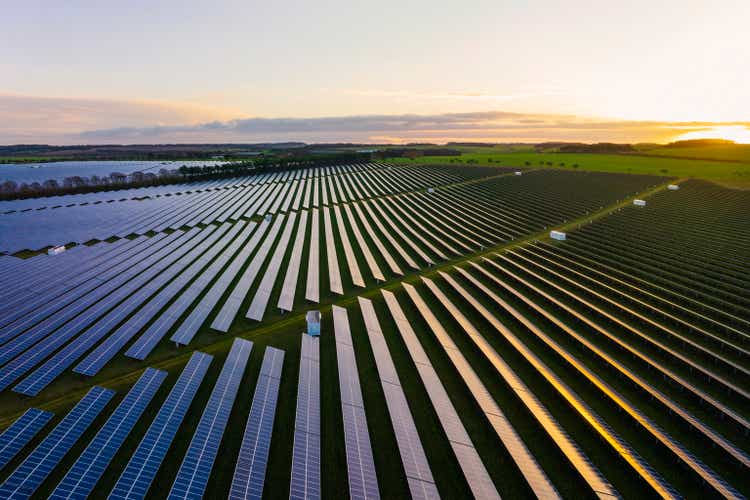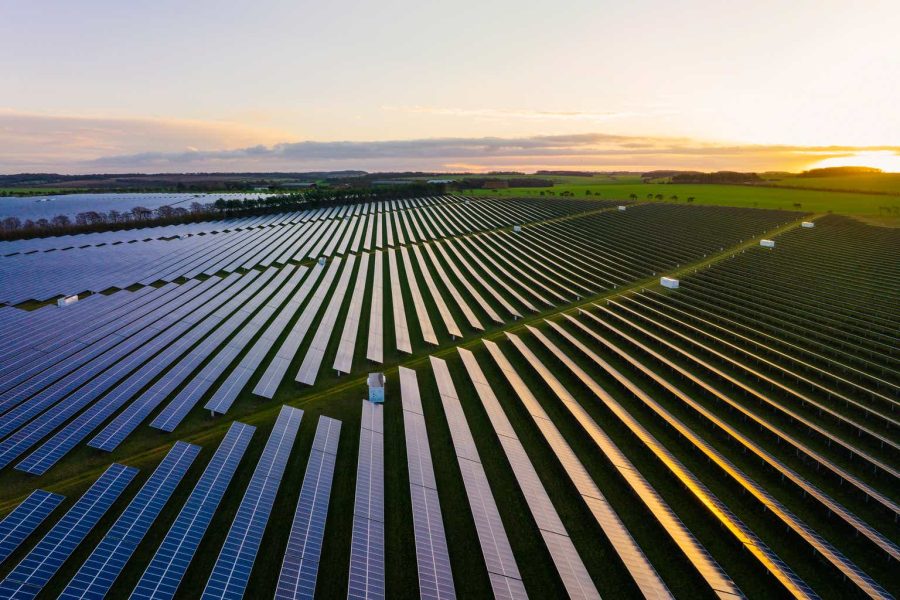Summary:
- SolarEdge’s revenue has stabilized, with multiple positive catalysts including normalized U.S. inventories, rebounding European demand, and rising U.S. electricity prices.
- The valuation of SEDG stock is low, and despite some risks facing the company, the balance sheet situation is manageable, making it a buy for risk-tolerant, long-term investors.
- SolarEdge’s Q2 revenue increased sequentially, driven by strong U.S. residential market sales and improved commercial sales, despite a year-over-year decline.
- Lower interest rates and growing solar installations in the U.S. and Europe, along with rising electricity prices, are expected to benefit SolarEdge significantly.
Justin Paget
SolarEdge’s (NASDAQ:SEDG) revenue appears to have at least stabilized. Meanwhile, the firm should benefit from multiple, positive catalysts in the medium-to-long term, including the normalization of inventories in the U.S., rebounding demand in Europe, lower interest rates, strong demand for solar energy for use in powering data centers in the U.S., and higher electricity prices in America.
The valuation of SEDG stock is now quite low. And on the balance sheet front, the company’s situation, although somewhat risky, is likely to be manageable.
In light of these points, I rate the shares as a buy for risk-tolerant, long-term, growth investors looking for exposure to the solar sector.
The Stabilization of the Company’s Overall Business
Encouragingly, SolarEdge’s revenue jumped 30% in the second quarter compared with the first quarter to $265 million. Moreover, its channel partners’ revenue from selling SolarEdge’s solar products climbed 18% in Q2 versus Q1.
It’s true that the firm’s top line still sank 73% versus the same period a year earlier. But the sequential increase in its sales was the first such gain since the second quarter of 2023. And at the midpoint of the company’s Q3 guidance range of $260 million to $290 million, its top line would rise sequentially again in Q3.
Moreover, there were multiple, other bright spots besides the headline numbers. For example, the firm’s gross loss sank to $7.2 million in Q2 versus $20.8 million in Q1, while its operations burned $45 million of cash.
That was way lower than the $217 million of cash that its operations burned in Q1 and significantly below the $88.7 million of cash that its businesses used in Q2 of 2023.
Meanwhile, the sales of its inverters and optimizers within the U.S. residential market jumped 32% versus Q1, and the revenue that it obtained by selling batteries within that market soared 55% quarter-over-quarter.
Former CEO Zvi Lando, speaking on the company’s Q2 earnings call, attributed the improvement in its revenue from inverters and optimizers to the increased market share of large installers and third-party owners within the U.S. residential market.
He explained that the company has traditionally done well in those segments. As far as the increase in the company’s revenue from selling batteries to the U.S. residential market, Lando stated that consumers were recognizing the positive attributes of the company’s “DC-coupled backup storage system,” particularly during extended electricity outages.
Providing evidence for Lando’s contentions, Newsweek reported last month that SolarEdge “offers some of the best energy storage products on the market.” It added that the company’s “residential batteries are perfect for those replacing an existing SolarEdge inverter or designing a brand-new energy system.” Finally, it noted that the batteries offer “94.5% round-trip efficiency.”
On the commercial side in America, SolarEdge’s sales climbed 18% versus Q1 and 13% year-over-year.
Normalized U.S. Inventories and Healthy Demand in Europe
In July, SolarEdge laid off 400 of its employees, citing high inventories among its customers and weakness in Europe.
But as of Aug. 13, the situation appears to have improved somewhat. Speaking at a conference, the company’s head of investor relations, J.B. Lowe, predicted that inventories in the U.S. would be “largely balanced by the end of Q3.” And Lowe added that the demand for the firm’s products in Europe, aside from the Netherlands, had generally rebounded in Q2 versus Q1, indicating that “the market is generally healthy.” However, he did note that inventories in Europe would take “multiple more quarters” to normalize.
The Proliferation of Data Centers and Rising Electricity Prices in the U.S.
As I’ve noted in past columns, U.S. electricity demand, after staying largely flat for decades, is expected to climb 9% “by 2028,” and electricity prices will increase by an average of almost 20% between 2025 and 2028, according to consulting firm ICF. Also, importantly, many data center operators have committed to using renewable energy to power their facilities, and the number of data centers in the U.S. is expected to surge amid the AI boom.
Solar Continue to Grow Rapidly in the U.S. and Europe, Lower Rates Will Be Positive
Unsurprisingly, given these dynamics, solar installations continue to increase rapidly in the U.S. Last quarter, the country added 9.4 gigawatts of capacity, representing a year-over-year gain of 29%. And in Europe, the amount of electricity generated by solar energy climbed by 23 terawatt hours versus the first half of 2023.
Meanwhile, lower interest rates make it much less costly for consumers and businesses to place solar panels on their roofs. As a result, rate cuts tend to be positive for solar stocks, including SEDG stock. With the Fed likely poised to embark on a rate cut cycle, SEDG should perform well for some time.
The Risks Facing SolarEdge
The continued inventory glut in Europe is likely to weigh on SolarEdge’s financial results going forward. Moreover, the company’s CEO, Zvi Lando, stepped down last month, citing the company’s need for new energy and leadership. Lando’s sudden departure could indicate that the company’s outlook is less bullish than it appears. But I think, given the company’s stabilization and positive catalysts, chances are higher that the firm’s board disagreed with a number of his decisions. Of course, the new CEO, who will replace the firm’s interim leader, may make bad moves, particularly at the beginning of his or her tenure.
SolarEdge’s balance sheet poses some risk for investors. But it had $690 million of cash and short-term investments as of the end of Q2, while it is slated to make a $347.5 million payment on its convertible notes in Q3 of 2025.
Assuming that the company’s cash burn continues to decline, I don’t believe that the firm will have difficulty making the payment or convincing banks to lend it more money. I’m particularly convinced of the latter point because interest rates will most likely be significantly lower in Q3 of 2025 than they are now.
SolarEdge’s Valuation
In terms of valuation, SEDG stock is changing hands with a forward enterprise value/ sales ratio of just 1.1, well below the sector’s average ratio of 2.84. Conversely, another large inverter maker, Enphase Energy (ENPH), has a much larger forward Enterprise Value/Sales ratio of 10.4, while solar panel maker First Solar (FSLR) weighs in with a forward Enterprise Value/Sales ratio of 5.2.
Additionally, SolarEdge’s forward price-to-book ratio is just 0.66, very far below the sector average of 4.2.
The Bottom Line on SolarEdge
Although SolarEdge certainly has significant problems and risks, its business appears to have stabilized, and it should benefit from multiple, positive catalysts going forward. Moreover, its valuation is attractive.
In light of these points, I believe that risk-tolerant, long-term, growth investors who are looking for increased exposure to solar energy should consider devoting a small percentage of their portfolios to SolarEdge.
Analyst’s Disclosure: I/we have no stock, option or similar derivative position in any of the companies mentioned, and no plans to initiate any such positions within the next 72 hours. I wrote this article myself, and it expresses my own opinions. I am not receiving compensation for it (other than from Seeking Alpha). I have no business relationship with any company whose stock is mentioned in this article.
Seeking Alpha’s Disclosure: Past performance is no guarantee of future results. No recommendation or advice is being given as to whether any investment is suitable for a particular investor. Any views or opinions expressed above may not reflect those of Seeking Alpha as a whole. Seeking Alpha is not a licensed securities dealer, broker or US investment adviser or investment bank. Our analysts are third party authors that include both professional investors and individual investors who may not be licensed or certified by any institute or regulatory body.
